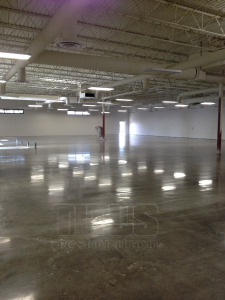 Concrete polishing is here to stay – it is specified in many retail environments, big box stores, schools, and large warehouse and manufacturing plants today. It’s benefits outweigh any other flooring option available, but how do you know if you are getting a true polish or a false polish on your concrete?
Concrete polishing is here to stay – it is specified in many retail environments, big box stores, schools, and large warehouse and manufacturing plants today. It’s benefits outweigh any other flooring option available, but how do you know if you are getting a true polish or a false polish on your concrete?
Here are some tips to look for from a good polished concrete contractor:
Good Concrete Polish Characteristics:
1. Don’t Skip Steps:
- There are many polished concrete contractors today who are cutting costs by skipping steps or combining diamond step. This not only gives the industry and the process a poor reputation, but the customer is not getting what they have paid for.
- What skipping steps does: Lessens refinement – this reduces shine, cleanability, and longevity – all the properties that are benefits of polished concrete are lost.
2. Wet Polish vs Dry Polish:
- The tools that are used for polishing are diamonds embedded in metal and resin material. When the dry polish method is used, these resins become very hot and melt into the tiny holes in the floor that can be exposed during the initial grinding phases of the process. This coats the floor like a wax and becomes very shiny, however, over time the shine is dulled by autoscrubbers, grocery carts, and foot traffic. Wet polishing on the other hand, cools the resins so they do not melt, resulting in a shine from refinement of scratch patterns (similar to sanding wood) versus a “false resin shine”. Sometimes 30-50 shine meter reading difference can be achieved, but it is only temporary. In addition, wet polishing extends the life of these diamonds so the pricing is better for your bottom line.
- When concrete is dry polished, concrete densifier penetration is stopped. This is because once the pores are filled with the resin from the dry polishing process, the densifier cannot pass through it.
- Finally, dry polishing creates very hazardous dust in the environment, dust that can be harmful to the health of those around and linger in HVAC systems for a long time. Sometimes this dust cannot be seen – this is the most harmful dust and the dust that causes Silicosis.
A good concrete polish starts and end with the safety and quality of a wet polish process.
*Although with wet polishing there is the added expense for disposal of the waste water, it is minimal compared to what you are achieving.
3. Densifier Choice: Of the densifiers available; potassium-, sodium-, and lithium-based.
- Sodium and Potassium are water soluble: densifier will also create a shine on the floor as it fills the pores, however, it is water soluble and the pores that it fills will eventually be unfilled from a normal maintenance programs.
- Sodium and Potassium are larger molecules, so they don’t penetrate as deep.
- Sodium and Potassium are higher pH they react quicker.
- Lithium-based densifier does not have the same reaction with water, it reacts with the elements of the concrete as much as it can (if properly installed) and hardens there.
To achieve the best penetration for a good concrete polish, lithium silicate densifier has a slower reaction time and longer lasting properties when used with wet polishing.
4. Equipment Choice and Tooling – the equipment and tooling should be based on the floor. We have here different types of equipment to acheive a good concrete polish.
- Titus has both propane and electric equipment based on the size and needs of the job.
- With propane there are no electrical cords to hassle with and they can be operated easier with one man (not a 2nd man dragging electrical cords and vacuums).
- Titus has floating or rigid machines:
- Floating heads are flexible, this allows them to reduce sand loss which will make the floor less shiny because tiny holes refract the light vs reflect the light.
- Rigid head are fixed and are able to cut the floor better if flatness or roughness is an issue.
- There are varying qualities of diamond tooling. Titus has done extensive testing and research on the diamond tooling used on its projects. Diamond size, hardness, and price are factors of a quality diamond tool.
Choosing the equipment and tooling for the job determines if you are going to get a good concrete polish or a mediocre one.
Who Titus Is – While some polishing companies have marketed themselves for museum-quality floors, others have gone after bigger work in bulk, getting as much work as possible and doing it cheap and quick. Titus has a place in the market for industrial and highly commercial concrete restoration. We not only offer this type of polishing, but we repair spalling joints and sweating slab syndrome and other specialties, but mainly we guide our customers to the lowest cost/lowest maintenance option that is environmentally safe, starting with a good concrete polish.
